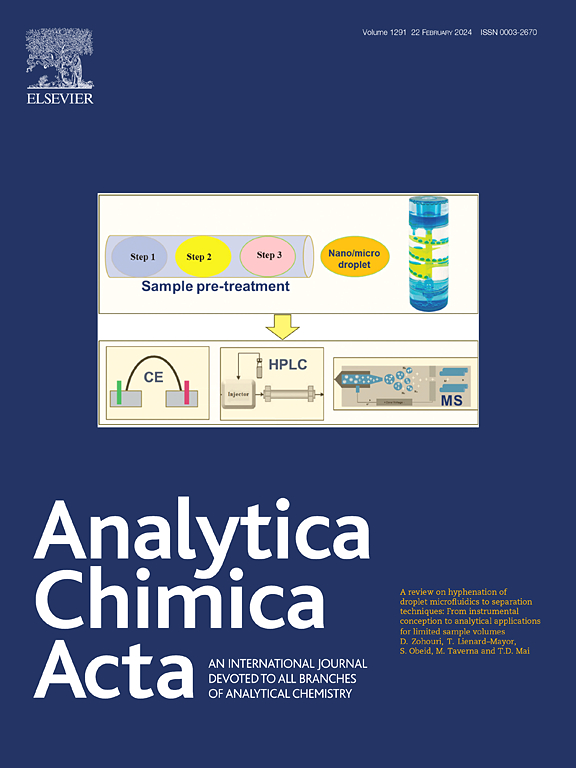LC-MS/MS-based测定干血斑中25-羟基维生素D:结合红细胞压积知识的可靠提取至关重要
IF 5.7
2区 化学
Q1 CHEMISTRY, ANALYTICAL
引用次数: 0
摘要
虽然有许多基于液相色谱-串联质谱(LC-MS/MS)的方法用于使用干血斑(DBS)测定25-羟基维生素D (25OHD),但这些方法都没有全面评估所采用提取方法的鲁棒性。后者是至关重要的,因为红细胞压积(Hct)和DBS老化可能会影响分析物的回收率,从而影响所获得的基于DBS的25OHD结果的准确性。此外,由于DBS在25OHD诊断中的应用潜力主要在于对新生儿筛查或流行病学研究背景下收集和存档的DBS进行分析,因此Hct和年龄变化可能会有较大变化。结果在60℃条件下,在50/50乙腈/水中热摇1 h,从单个6 mm DBS冲床中提取25OHD, Hct范围为0.23 ~ 0.53 L/L,与Hct和老化无关。优化后的LC-MS/MS-based方法允许使用逆梯度快速(<2 min)从25OHD3中分离3-epi-25OHD3,而无需专用色谱柱。该方法可用于DBS、全血和血浆中25OHD3和25OHD2的定量,DBS和全血中25OHD3和25OHD2的定量下限分别为1.97和2.53 ng/mL,血浆中25OHD3和25OHD2的定量下限分别为3.94和5.06 ng/mL。对于25OHD3和25OHD2,所有矩阵的精度和不精度分别在-14.7%到2.3%和1.1%到10.0%之间。稳定性研究(室温保存3个月前)以及斑点血容量评估均未显示对DBS中25OHD的定量有任何相关影响。最后,一项概念验证研究表明,当考虑到Hct时,DBS和全血样本以及血浆浓度可以分别获得可比的结果。本文首次深入解决了从DBS中测定25OHD的主要研究空白之一,即所采用提取程序的鲁棒性评估。通过高温热摇,我们证明了25OHD3和25OHD2的恢复与Hct和年龄无关,证实了该方法适用于新生儿筛查和流行病学研究等大规模应用。本文章由计算机程序翻译,如有差异,请以英文原文为准。

LC-MS/MS-based determination of 25-hydroxyvitamin D in dried blood spots: crucial importance of combining a robust extraction with knowledge of the hematocrit
Background
While many liquid chromatography – tandem mass spectrometry (LC-MS/MS)-based methods exist for the determination of 25-hydroxyvitamin D (25OHD) using dried blood spots (DBS), none of these comprehensively evaluated the robustness of the employed extraction method. The latter is critical as the hematocrit (Hct) as well as DBS ageing may affect analyte recovery and, thus, the accuracy of the obtained DBS-based 25OHD result. Moreover, as the application potential of DBS for the determination of 25OHD mainly lies in the analysis of DBS collected and archived in the context of newborn screening or epidemiological studies, a large variation in Hct and ageing is to be expected.Results
A Hct- and ageing-independent extraction of 25OHD from a single 6 mm DBS subpunch was obtained in the Hct range of 0.23 to 0.53 L/L, using thermoshaking in 50/50 acetonitrile/water for 1 h at 60 °C. The optimized LC-MS/MS-based method allowed fast (<2 min) separation of 3-epi-25OHD3 from 25OHD3 using an inverse gradient without the need for a dedicated column. The method was successfully validated for the determination of 25OHD3 and 25OHD2 in DBS, whole blood and plasma, with lower limits of quantification of 1.97 and 2.53 ng/mL in DBS and whole blood, and 3.94 and 5.06 ng/mL in plasma for 25OHD3 and 25OHD2, respectively. For both 25OHD3 and 25OHD2, accuracy and imprecision were respectively within -14.7% to 2.3% and within 1.1% to 10.0% for all matrices. Stability studies (up until three months of storage at room temperature) as well as the evaluation of spotted blood volume did not reveal any relevant impact on the quantification of 25OHD in DBS. Finally, a proof-of-concept study indicated that, when the Hct is taken into account, comparable results can be obtained in DBS and whole blood samples and plasma concentrations can be derived from DBS, respectively.Significance and novelty
The presented manuscript is the first to address in-depth one of the major remaining research gaps in the determination of 25OHD from DBS, namely the evaluation of the robustness of the employed extraction procedure. Using thermoshaking at elevated temperature, we demonstrated Hct- and ageing-independent recovery of 25OHD3 and 25OHD2, confirming the method’s suitability for large-scale applications such as newborn screening and epidemiological studies.求助全文
通过发布文献求助,成功后即可免费获取论文全文。
去求助
来源期刊

Analytica Chimica Acta
化学-分析化学
CiteScore
10.40
自引率
6.50%
发文量
1081
审稿时长
38 days
期刊介绍:
Analytica Chimica Acta has an open access mirror journal Analytica Chimica Acta: X, sharing the same aims and scope, editorial team, submission system and rigorous peer review.
Analytica Chimica Acta provides a forum for the rapid publication of original research, and critical, comprehensive reviews dealing with all aspects of fundamental and applied modern analytical chemistry. The journal welcomes the submission of research papers which report studies concerning the development of new and significant analytical methodologies. In determining the suitability of submitted articles for publication, particular scrutiny will be placed on the degree of novelty and impact of the research and the extent to which it adds to the existing body of knowledge in analytical chemistry.
 求助内容:
求助内容: 应助结果提醒方式:
应助结果提醒方式:


